HiPACC Computational Astronomy Press Room. From: UCR
The Press Room highlights computational astronomy work around the UC-HiPACC consortium; the wording of the short summaries on this page is based on wording in the individual releases or on the summaries on the press release page of the original source. Press releases below appear in reverse chronological order (most recent first); they can also be displayed by UC campus or DOE lab by clicking on the desired venue at the bottom of the left-hand column.
October 9, 2014 — UC Riverside’s ‘Alternative Earths’ team selected to join the NASA Astrobiology Institute
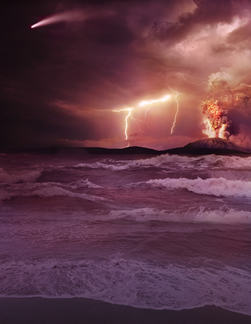
Artist concept of an early Earth. Credit: NASA
UCR 10/9/2014—How can astronomers looking at Mars or planets in distant solar systems tell whether they support life? Researchers at UC Riverside will share a $50 million grant from the NASA Astrobiology Institute to help answer that question by studying ancient rocks on Earth to determine how oxygen developed in our atmosphere billions of years ago. Specifically, UCR’s team will spend five years trying to map the different states of life on Earth from 3.2 billion years ago—when bacteria may have first begun oxygen-producing photosynthesis—to about 700 million years ago, about the time animals came on the scene, said UCR Distinguished Professor of Biogeochemistry Timothy Lyons, leader of the “Alternative Earths” team. “The question is, what can we learn from early Earth to inform our exploration of life in the universe?” Lyons said. Specifically, if you were observing Earth from light-years away 3 billion years ago, what kind of evidence would confirm that our planet was habitable, and in fact teeming with life?
View UCR Press Release
January 7, 2014 — Hubble unveils a deep sea of small and faint early galaxies

An image taken with the Hubble Space Telescope of Abell 1689, a massive cluster of galaxies whose gravitational pull is so strong that it bends light, acting like a lens. (Photo: NASA and ESA; Space Telescope Science Institute)
UC Riverside — A team of scientists led by astronomers at UC Riverside has used NASA’s Hubble Space Telescope to uncover the long-suspected underlying population of galaxies that produced the bulk of new stars during the universe’s early years. The 58 young, diminutive galaxies, captured by Hubble deep exposures taken in ultraviolet light, are the smallest, faintest, and most numerous galaxies ever seen in the remote universe. These galaxies bolster claims that hot stars in small galaxies pumped out enough radiation to ionize hydrogen by stripping off electrons — a process called “reionization” that occurred about 13 billion years ago, within the first billion years after the Big Bang.
Read full UC Riverside press release
October 23, 2013 — UC Riverside Astronomers Help Discover the Most Distant Known Galaxy
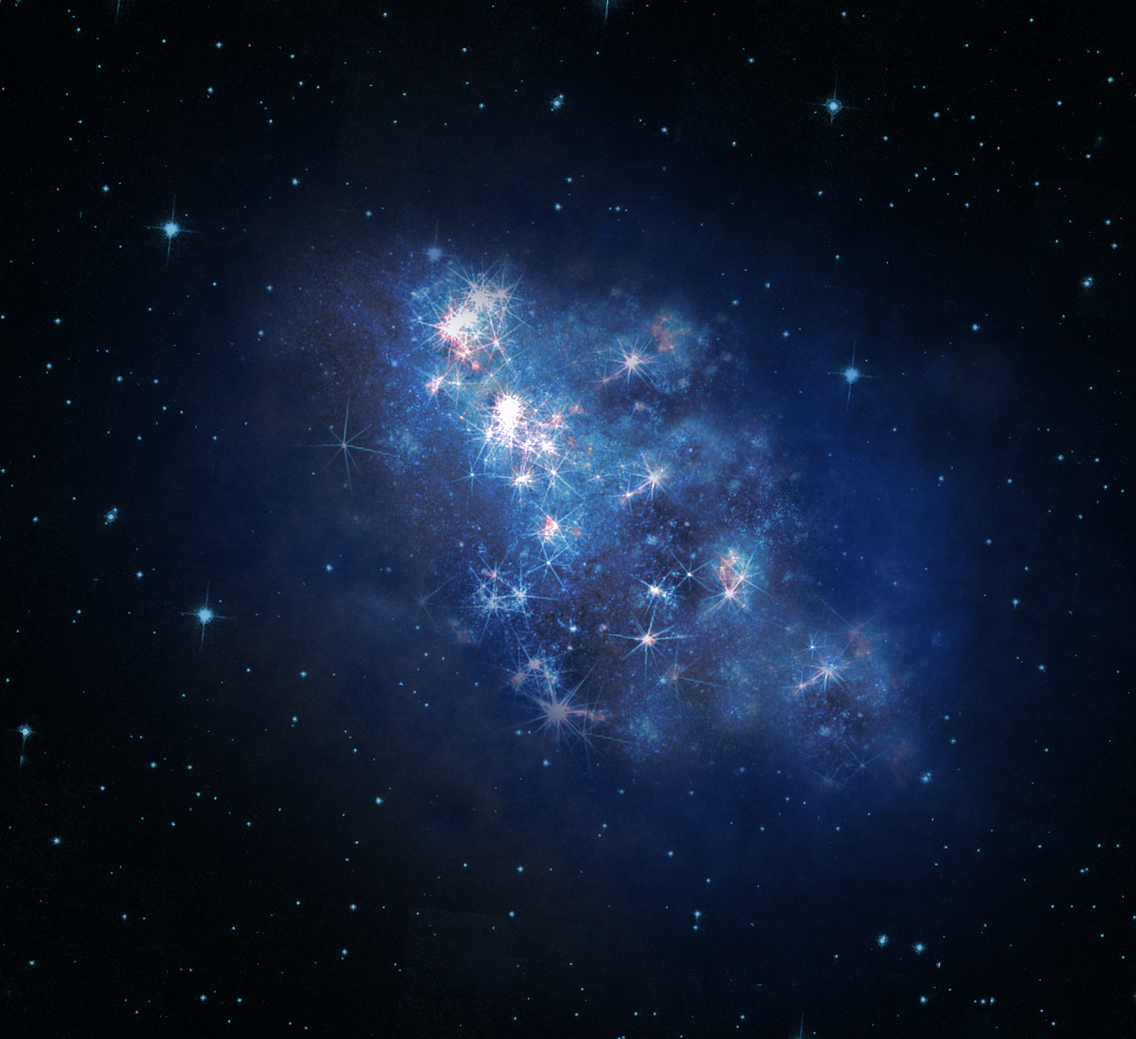
An artist's rendition of the newly discovered most distant galaxy z8-GND-5296.
Two University of California, Riverside astronomers are members of a team that has discovered the most distant galaxy ever found. The galaxy is seen as it was just 700 million years after the Big Bang, when the universe was only about 5 percent of its current age of 13.8 billion years.
view full UCR Press Release
September 16, 2013 — Research project to capture infrared view of distant universe

The reflection of Brian Siana in the primary mirror of the Keck telescope. The telescopes’ mirrors are made of 36 hexagonal segments.
Astronomers at the University of California, Riverside have received a three-year grant from the National Science Foundation to conduct a very large new survey of galaxies using a new instrument — MOSFIRE — on the Keck I telescope at the summit of Mauna Kea on Hawai`i’s Big Island. The $975,000 grant for the MOSFIRE Deep Evolution Field (MOSDEF) Survey will be divided among four campuses: UC Riverside, UCLA, UC Berkeley and UC San Diego. The survey will use the MOSFIRE instrument to obtain near-infrared spectra of nearly 2,000 galaxies as they were forming 9-12 billion years ago, ten times more than have been taken before. The spectra will allow the scientists to determine how quickly the galaxies are converting their gas into stars, how the supernovae of those stars enriched the galaxies with the heavier elements (carbon, nitrogen, oxygen, etc.), of which humans and Earth are made. It will accurately measure the obscuring effects of dust in the galaxies, and reveal the transition from nascent to mature galaxies during the epoch when most of the stars in the universe formed.
view full UCR Press Release
May 24, 2013 — Astronomers Measure the Elusive Extragalactic Background Light
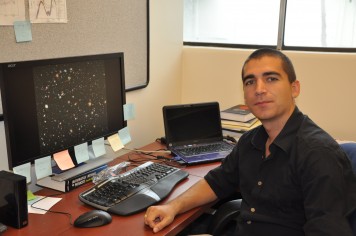
Alberto Domínguez is a a postdoctoral researcher in the Department of Physics and Astronomy at UC Riverside.
UC Riverside-led team relies on the attenuation of high-energy gamma rays from supermassive black holes to come up with a solution for how to measure all the light ever emitted in the universe.
view full UCR Press Release
May 24, 2013 — Detection of the cosmic gamma ray horizon: Measures all the light in the universe since the Big Bang

The attached figure illustrates how energetic gamma rays (dashed lines) from a distant blazar strike photons of extragalactic background light (wavy lines) and produce pairs of electrons and positrons.
How much light has been emitted by all galaxies since the cosmos began? The Universe is suffused in a bath of almost every photon (particle of light) from ultraviolet to far infrared wavelengths ever radiated by all galaxies that ever existed throughout cosmic time. An accurate measurement of this extragalactic background light (EBL) is as fundamental to cosmology as measuring the heat radiation left over from the Big Bang (the cosmic microwave background) at radio wavelengths. A new paper, called "Detection of the Cosmic γ-Ray Horizon from Multiwavelength Observations of Blazars," by Alberto Dominguez and six coauthors, just published by the Astrophysical Journal—based on observations spanning wavelengths from radio waves to very energetic gamma rays, obtained from several NASA spacecraft and several ground-based telescopes—describes the best measurement yet of the evolution of the EBL over the past 5 billion years.
view full Press Release
February 21, 2013 — UC Riverside Astronomer Awarded Sloan Research Fellowship
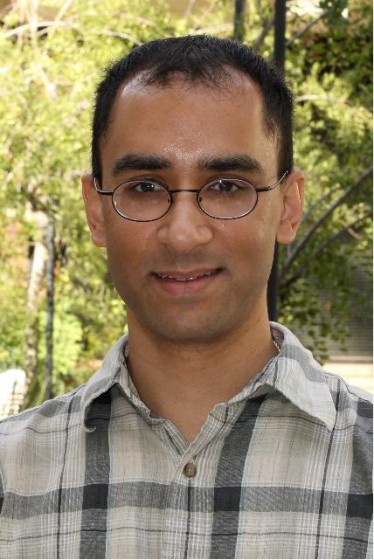
Naveen Reddy is an assistant professor of physics and astronomy at UC Riverside.
UC Riverside’s Naveen Reddy has been awarded a prestigious Sloan Research Fellowship from the Alfred P. Sloan Foundation. Reddy, who studies distant galaxies and their evolution in cosmic time, is working on several projects aimed at understanding the history of star formation and buildup of stellar mass in the universe.
view full UCR Press Release
November 29, 2012 — High Honor for Two Physicists
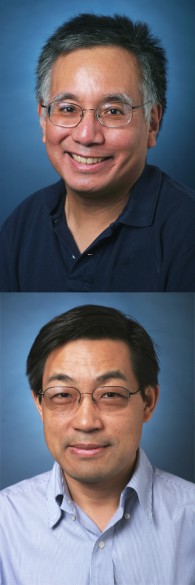
Richard Seto (top) and Jing Shi are professors of physics and astronomy at UC Riverside.
By Iqbal Pittalwala
Two physicists at the University of California, Riverside — Richard Seto and Jing Shi — have been elected as fellows of the American Physical Society (APS). Only 250 researchers received the high honor this year.
The APS represents more than 50,000 members, including physicists in academia, national laboratories and industry in the United States and throughout the world. Fellowship in the society is limited to no more than one half of one percent of the membership. The evaluation process for fellowship election is done entirely by one’s professional peers.
view full UCR Press Release
March 29, 2012 — Data Mining Deep Space
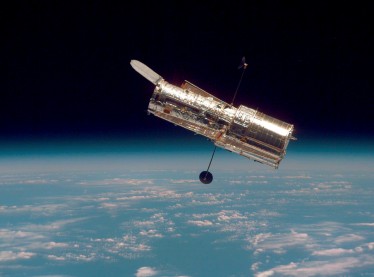
The Hubble Space Telescope. NASA
UC Riverside’s Bahram Mobasher has received a NASA grant to compile data from the Hubble Space Telescope
By Iqbal Pittalwala
RIVERSIDE, Calif. — Bahram Mobasher, a professor of physics and astronomy at the University of California, Riverside, has received a two-year $200,000 grant from NASA to compile into a data bank all the imaging observations of galaxy surveys that the Hubble Space Telescope has performed since 2002, when a powerful imaging instrument, the Advanced Camera for Surveys, was installed on the telescope.
Carried into orbit in 1990, the Hubble Space Telescope still remains in operation, and is one of the world’s most famous, popular and productive scientific instruments. Because of its orbit outside the Earth’s atmosphere, it is capable of taking extremely sharp images of galaxies in the most distant parts of the universe.
“This is a tremendously exciting data-mining project, a legacy program with a final product enormously useful for astronomers worldwide,” Mobasher said.
The Hubble imaging data will be supplemented by observations for the same galaxies in different wavelengths, taken from other ground-based and space-borne observatories...
view full UCR Press Release








